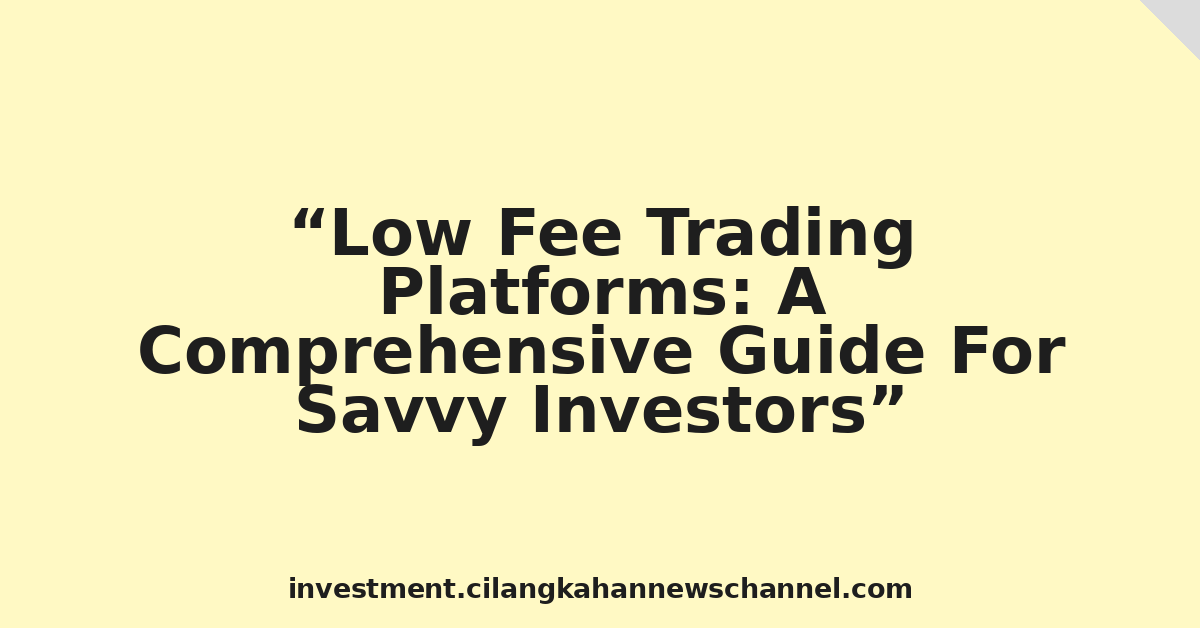The world of online trading has exploded in recent years, offering unprecedented access to global markets for individual investors. However, navigating this landscape can be challenging, particularly when considering the fees associated with different platforms. Choosing a low-fee trading platform is crucial for maximizing returns and minimizing the impact of trading costs on your investment portfolio. This comprehensive guide will explore the key features to look for in a low-fee platform, compare various options available, and provide insights to help you make an informed decision.
Hello Readers of investment.cilangkahannewschannel.com, the pursuit of financial freedom often involves making smart choices about where and how you invest your money. One of the most significant factors impacting your overall profitability is the cost of trading itself. While the allure of high returns is undeniable, consistently high trading fees can significantly erode your gains over time. This article is designed to empower you with the knowledge necessary to identify and utilize low-fee trading platforms effectively. We’ll delve into the nuances of different fee structures, helping you navigate the complexities and choose the platform that best aligns with your investment goals and trading style.
Understanding Different Fee Structures:
Before diving into specific platforms, it’s crucial to understand the various fee structures you’re likely to encounter. These fees can significantly impact your bottom line, so understanding them is paramount.
-
Commission Fees: These are per-trade fees charged by brokers for executing your buy or sell orders. They can vary widely depending on the platform, the asset class (stocks, options, futures, etc.), and the volume of trades. Some platforms advertise "commission-free" trading, but it’s essential to understand if other fees offset this benefit.
-
Spread Fees: For certain asset classes like forex and CFDs (Contracts for Difference), the spread represents the difference between the bid and ask price. The broker profits from this spread, and wider spreads translate to higher trading costs. Low-fee platforms often strive to offer competitive spreads.
-
Account Fees: Some platforms charge monthly or annual account maintenance fees, regardless of your trading activity. This is something to consider, especially if you’re a less active trader.
-
Data Fees: Access to real-time market data can be a significant cost, especially for active traders. Some platforms include this in their commission fees, while others charge separately.
-
Withdrawal Fees: Fees for withdrawing funds from your trading account can also add up, particularly if you make frequent withdrawals.
-
Inactivity Fees: Some brokers charge fees if your account remains inactive for a prolonged period.
Key Features of Low-Fee Trading Platforms:
Beyond the fees themselves, several other features contribute to a positive trading experience. Look for platforms that offer:
-
User-Friendly Interface: A well-designed platform is intuitive and easy to navigate, even for beginners. Complex interfaces can lead to errors and frustration.
-
Robust Research Tools: Access to reliable market research, charting tools, and analytical resources is essential for informed decision-making.
-
Mobile App: The ability to trade on the go through a mobile app is increasingly important for today’s investors. Ensure the app is user-friendly and reliable.
-
Customer Support: Responsive and helpful customer support is vital, especially when dealing with technical issues or account-related inquiries.
-
Security: Security should be a top priority. Choose a platform with robust security measures to protect your funds and personal information.
-
Educational Resources: Many platforms offer educational resources such as webinars, tutorials, and articles to help you improve your trading skills.
Comparing Low-Fee Trading Platforms:
Several platforms stand out for their low fees and comprehensive features. However, the "best" platform depends on your individual needs and trading style. Some popular options include:
-
Robinhood: Known for its commission-free trading of stocks and ETFs, Robinhood has gained immense popularity among beginner investors. However, it’s essential to be aware of its limitations, such as limited research tools and occasional outages.
-
Webull: Similar to Robinhood, Webull offers commission-free trading and a user-friendly interface. It also provides fractional shares and advanced charting tools.
-
Fidelity: A well-established brokerage firm, Fidelity offers a wide range of investment options, competitive fees, and excellent research tools. While not strictly "commission-free," its fees are generally low and competitive.
-
Charles Schwab: Another reputable brokerage with a strong reputation, Charles Schwab offers a comprehensive platform with competitive fees, excellent research, and robust customer support.
-
Interactive Brokers: Interactive Brokers caters to more active traders, offering access to a wide range of markets and advanced trading tools. While its fee structure can be complex, it often offers highly competitive pricing for active traders.
Choosing the Right Platform for You:
Selecting the optimal low-fee trading platform requires careful consideration of your individual circumstances. Ask yourself the following questions:
-
What are your investment goals? Are you a long-term investor or a day trader? Your trading frequency will significantly impact your fee structure.
-
What asset classes are you interested in? Some platforms specialize in specific asset classes, while others offer broader access.
-
What is your level of trading experience? Beginners may benefit from platforms with user-friendly interfaces and educational resources.
-
What level of customer support do you require? Active traders may need more responsive customer support than less active investors.
-
What are your technological requirements? Ensure the platform’s website and mobile app are compatible with your devices.
Conclusion:
Choosing a low-fee trading platform is a critical decision for any investor. By understanding the different fee structures, comparing various platforms, and considering your individual needs, you can significantly reduce your trading costs and maximize your investment returns. Remember to always prioritize security, user experience, and the availability of robust research tools when making your selection. The information provided in this article serves as a starting point for your research; further investigation into individual platforms is strongly encouraged before making a final decision. Happy investing!

